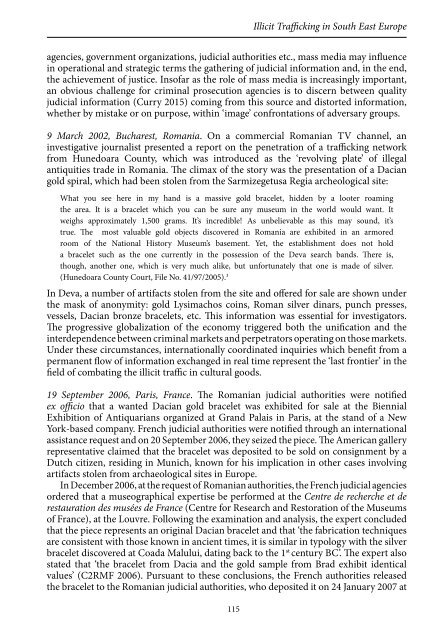Countering
Book_observatory_illicit_traffic_version%20issuu
Book_observatory_illicit_traffic_version%20issuu
Create successful ePaper yourself
Turn your PDF publications into a flip-book with our unique Google optimized e-Paper software.
Augustin Lazăr<br />
the Romanian National History Museum in Bucharest.<br />
After repatriation, the artifact was examined by Romanian experts who concluded<br />
that ‘the presented piece is a gold bracelet having more than one spiral pertaining to a<br />
category of typically Dacian jewelry […] dating back to the 1 st century BC’ and that it can<br />
be ‘considered a token of Dacian royal rank’ (Babes, Marinescu and Trohani 2007). It also<br />
stipulated that ‘as it is an original and comes from the Romanian territory, the examined<br />
bracelet is included in the national cultural heritage inventory, classified as treasure’<br />
for ‘bracelet no. 5, although exhibiting all the characteristics of the Dacian bracelets,<br />
distinguishes itself from the other 4 through its higher gold title as well as through an<br />
elaborate decorating style’ (Meyers in Hunedoara County Court, file no. 41/97/2005).<br />
February 2007, New York, USA. Upon finding out the true origin of the bracelet pair<br />
weighing 683 grams, a New York firm notified the Romanian judicial agencies, providing<br />
them with the pictures, invoices and an expertise report of both bracelets. The expertise<br />
report performed by a well known Los Angeles expert revealed the fact that the two<br />
pieces were original Thracian bracelets, made out of natural 22 karat gold: ‘the execution<br />
technique is consistent with the methods used to create ancient jewelry items’, and<br />
‘the combined technical indications, including those pertaining to the composition of<br />
common alluvial gold elements, the forging technique and the characteristics of the<br />
surface are consistent with the suggested creation date’ (Meyers 2005).<br />
The bracelet was examined by Dr Barbara Deppert, a Frankfurt-based expert, from<br />
whence it was recovered, upon confirmation of its origin through an international<br />
assistance request by Romanian judicial authorities. Pursuant to Article 4 of the<br />
Convention on Stolen or Illegally exported Cultural Objects signed in Rome on 24<br />
June, 1995, ratified by Romania through the Law 149/1997, the Ministry of Culture, as<br />
a representative of the rightful owner, the Romanian State, paid the fair and reasonable<br />
compensation to W. & Co, which was in fact the amount the firm had paid to purchase<br />
the items. In order to retrieve the paid compensation, precautionary measures regarding<br />
the goods of the concerned individuals were taken.<br />
On 2 August 2007, the pair-bracelet was remanded in custody of the Romanian<br />
National History Museum. The subsequent expertise led to the following conclusions: i)the<br />
execution technique and the bracelet’s decorative art (i.e. bracelet no. 9) are consistent with<br />
those of the Dacian silver bracelets from the 2 nd and the 1 st centuries BC, as well as those<br />
of other Dacian or Geto-Dacian jewelry discovered in Romania, ii) they were therefore<br />
undoubtedly crafted under the guidance of the same craftsman: ‘the objects subjected to<br />
expertise (i.e. bracelet no. 9) are original Dacian jewelry items from the 2 nd and the 1 st<br />
centuries BC’ (Constantinescu, Niculescu and Oberländer-Târnoveanu 2007: 6).<br />
The subsequent reconstitution of the track the bracelets revealed the surprising fact<br />
that the two artifacts had been stolen in August 1999, from a small terrace overlooking<br />
the sacred area of the Sarmizegetusa Regia fortress (the coordinates of the poacher<br />
hole are established in the research report) and by the year 2001 the items were already<br />
monetized at the USA firm X LLC. On 27 December 2002, the pieces were examined<br />
by a Los Angeles expert, who confirmed their authenticity in his expertise report. With<br />
invoice no. 1439/7 of May 2004, issued by X LLC, the manager sold a 683 grams bracelet<br />
to a New York firm for $40,000. The second bracelet, weighing 764 grams, was sent to the<br />
same firm to be sold on consignment for $45,000 and, as it remained without a buyer, it<br />
was sent back to the manager on 21 February 2005. He sold the bracelet in August 2006<br />
to the New York firm for $30,000 and the piece was exhibited for sale at the Biennial<br />
116


